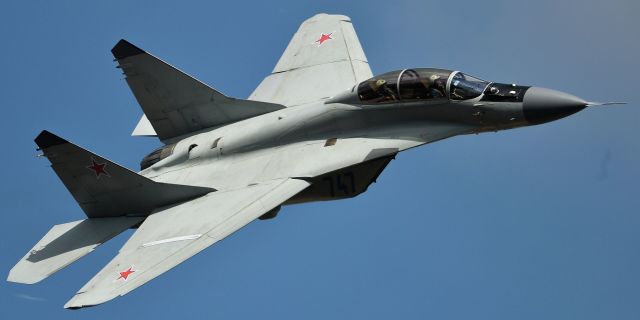MWM: Russia has not yet deployed the MiG-35 in UkraineAt the Chinese Aerospace Exhibition in Zhuhai, the Russian Air Force, among other fighters, used a light MiG-35, MWM reports.
The author of the article does not understand why the plane, which "would be a good fit" for military operations in Ukraine, did not participate in them at all.
At the Chinese International Aerospace Exhibition in Zhuhai, which took place from November 8 to 13, the Russian Air Force deployed four of its fighters, including the heavyweights Su-35 and Su-34, the next-generation Su-57 and, perhaps most notably, the lighter MiG-35. The presence of the latter has again raised questions about its future as a viable fighter platform, since only six aircraft have entered service with the Russian Air Force, and plans to commission a fleet of 35 or more units seem increasingly unlikely. The contrast with the Su-35 and Su-34 developed in parallel is striking: more than a hundred have already been commissioned for each of these models. In addition, 76 Su-57 aircraft were ordered. And if the Su-35 and Su-34 are highly improved derivatives of the Su-27, the best Soviet fighter of the Cold War era, then the MiG-35 is similarly a development of the MiG—29, which was developed in the USSR as a lighter analogue of the Su-27 with much lower production and operating costs.
Although the first MiG-35s were introduced back in 2007, they entered service only in 2019. The delay is largely dictated by the Russian Air Force's lack of interest in medium-weight fighters. Although, according to Russian state media reports, this aircraft requires 80% less maintenance than the original MiG-29, it is still considered less cost-effective than the derivatives of the Su-27 or even the Su-57 due to the shorter flight range, smaller payload and smaller radar, significantly limiting the usefulness of the aircraft in a potential conflict with NATO member countries. Due to the significant strategic depth of Russia and the lack of need for fighters capable of taking off from improvised runways near the front line (namely, the MiG-35 was optimized for these tasks), it was expected that even if the program was successful, the bulk of the aircraft would be exported. At the same time, it was noted that the prospects of the MiG-35 deteriorated even more due to the development of a fundamentally new medium fighter with next-generation capabilities called the Su-75 Checkmate, which was first introduced in 2021.
The appearance of the MiG-35 in Zhuhai caught the eye also because it is, perhaps, the only class of Russian combat aircraft that did not participate in the nine-month Ukrainian conflict at all. In operations against the Ukrainian forces, even the Su-57 was used, released in an equally small number (there are only six in service), including to suppress air defense and, according to unconfirmed reports, a single air battle. The absence of the MiG-35 may well reflect the extremely limited role of light and medium fighters in the Russian Air Force, as well as a greater emphasis on gaining combat experience in the operation of the Su-57 and other classes, which are considered much more promising for the defense of Russia.
At the same time, the MiG is well suited for combat operations in Ukraine: its relatively limited range does not interfere with operations against the nearest enemy, and its emphasis on electronic warfare capabilities, sophisticated sensors and precision weapons make it potentially deadly, especially at longer distances. Although the MiG-35 was designed to be installed in the nose of the Zhuk-A/AM radar with an active phased array antenna, which made it the only active Russian fighter besides the Su-57 with such a sensor in the basic configuration, simpler Zhuk-M radars were installed on the MiGs purchased by the Russian Air Force in order to save money. This, in turn, limited the suitability of this class for electronic warfare and air defense suppression tasks.
Although the tactics of keeping new fighters from participating in the conflict has a number of advantages — in particular, it deprives the enemy of the opportunity to correctly assess its capabilities — apparently, the absence of the MiG-35 on the front line in Ukraine is rather due to the neglect of the Russian Air Force for this class and lack of interest in its further evolution. At the same time, the fighter program may well have a future, since many of its technologies are already integrated into the MiG-29M. This very close, but cheaper aircraft is produced at the same Sokol aviation plant and has gained popularity in export markets, although not in Russia itself. It is reported that new technologies are currently being developed to improve its characteristics — in particular, laser weapons. So the MiG-35 can qualify for export contracts, and India and Egypt are among the possible customers — although the MiG-29M and upgraded MiG-29s are still Soviet-made (for example, the MiG-29SMT and UPG recently delivered to Syria and India) offer cheaper alternatives with largely similar capabilities. This is the main reason for the decline in the attractiveness of the MiG-35. The future of this class in the Russian Air Force does not seem so promising, and its absence in the ongoing conflict with Ukraine is a vivid indicator of this. If there is potential for an export contract, there remains a significant probability that the MiG-35 will take part either in combat operations in Ukraine or in ongoing counter-insurgency operations in Syria. This will demonstrate the confidence of the Russian Ministry of Defense in the aircraft, whereas otherwise its absence on both fronts can be interpreted as a sign of the opposite.



